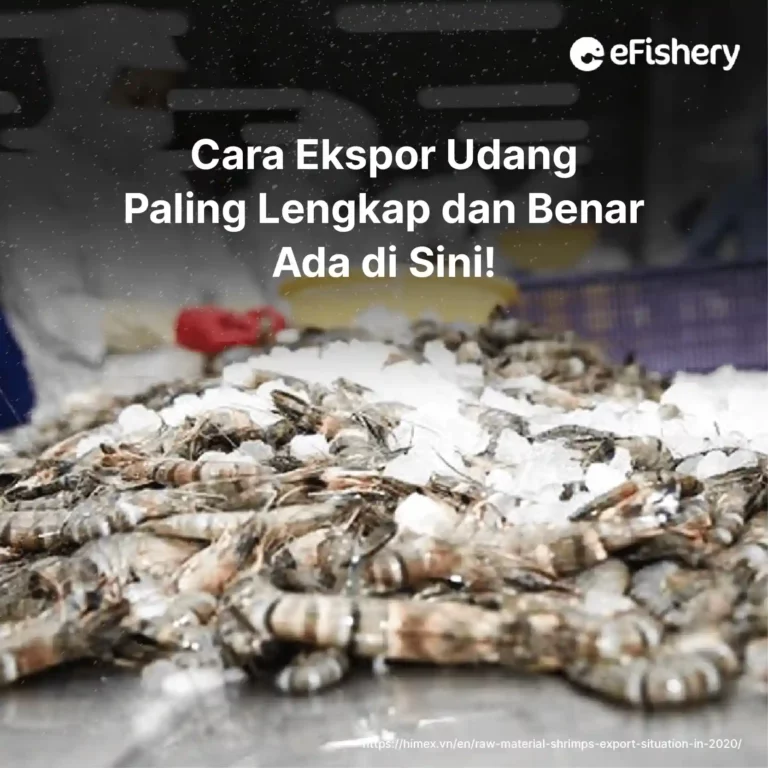Export of shrimp or shrimp exports success cannot be separated from the correct and procedural way to export shrimp. Many exporters fail to send their shrimp abroad because they ignore the procedures set by the governments of the exporting and importing countries. Want to know what procedures must be followed and what documents must be fulfilled in order to export shrimp abroad? Read this article to the end, come on!
Shrimp Export Procedures
A. Shrimp Export Terms
Shrimp export requirements are everything that must be met to ensure a smooth export process set by the Indonesian government. In order for your shrimp to be exported abroad, the following conditions must be met:
1. Obtain an Export Permit
Export license is the main requirement needed to export shrimp abroad. To get a shrimp export permit, you need to submit an application to the authorized agency, such as the Ministry of Maritime Affairs and Fisheries.
2. Meet Quality and Safety Standards
Before exporting, make sure that the shrimp meet the quality and safety standards set by the Fish Quarantine, Quality Control and Fishery Products Safety Agency (BKIPM). In this case, BKIPM will check the quality of the shrimp, the level of cleanliness, the accuracy of product labels, and others. Therefore, you must ensure that the shrimp meets the specified requirements to avoid problems during the export process.
3. Appropriate Packaging
Packaging is very important because it can maintain the quality of the shrimp during the export process. Therefore, you must carry out the packaging process as best as possible using packaging materials that are resistant to changes in temperature and humidity. In addition, you are also required to include product labels and other important information related to shrimp on the packaging.
4. Documents and Certificates for Shrimp Exports and the Criteria
The Government of Indonesia has established various documents and certifications required to meet the legal and security requirements for shrimp exports. Some of the documents that are generally needed are:
- Invoice
- HACCP Certificate (Hazard Analysis Critical Control Point), at least Grade B
- NIB (Business Identification Number)
- SIUP (Trading Business Permit) for Processing
- SKP (Tax Assessment Letter)
- Internal Audit Records
- Registration Application Letter Registration Number
- Statement of Utilization of Registration Number
5. Clear Labeling
Clear labeling on shrimp packaging is an important requirement in the export process. Make sure each package is labeled with accurate information that includes the product name, net weight, expiration date, and country of origin because clear and neat labels will facilitate product identification in the destination country.
6. Quality and Safety Monitoring
During the export process, it is important to regularly monitor the quality and safety of the shrimp. Make sure the prawns remain fresh and in good condition during the journey to the export destination country. Having an effective monitoring system in place and conducting regular testing will help you identify potential problems and take the necessary actions before the shrimp is exported.
7. Have HS Code
Harmonized System (HS) is a code that is created systematically to facilitate shrimp tariffs, trade transactions, transportation, and statistics. To obtain or determine HS code For shrimp export, you can follow the following method:
- Visit the page Indonesia National Single Window (INSW).
- Select a menu INDONESIA NTR, then select HS Code Information.
- Click on the Parameters section, then select BTBMI-Description in Indonesia.
- Enter a search word using Indonesian, for example "shrimp".
- Wait a few moments until various HS codes appear that match the search results.
- Check the HS code you need, then look for the HS code which consists of eight digits.
- Find the amount of import duties, VAT, PPH, and prohibitions or restrictions (Lartas).
- The process of registering the HS code has been completed.
B. Shrimp Export Procedures
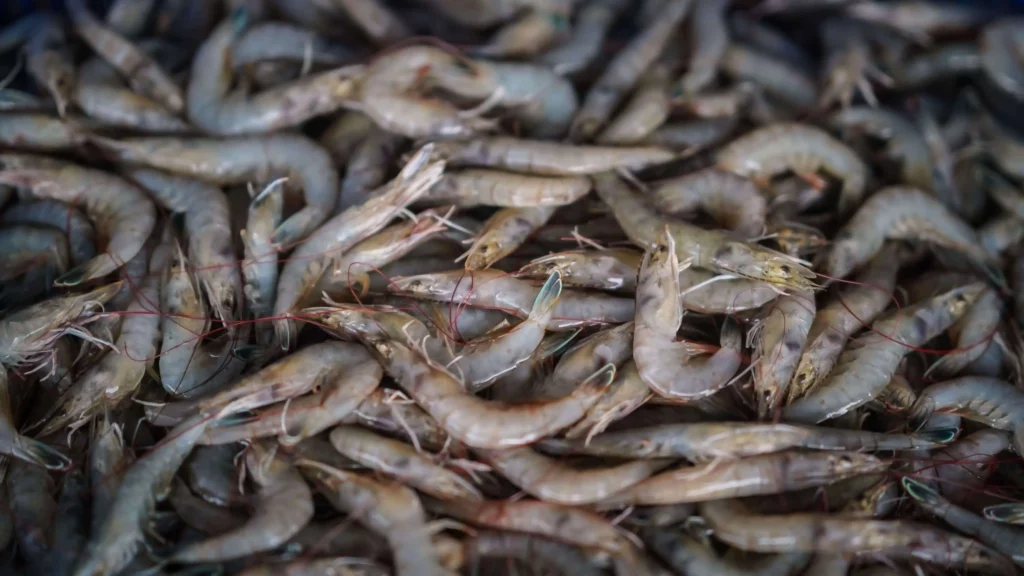
After completing the several requirements and documents mentioned above, here is the shrimp export flow that you need to follow:
1. Ask for a permit from the government
There are several types of government permits that you must have to be able to export shrimp:
- Industrial Permit from the Department of Industry
- Trading Business Permit from the Department of Trade
- Customs Master Certificate or Shrimp Export NIK
2. Following the Quarantine Process
The purpose of quarantine is to obtain shrimp health certification to be exported according to the requirements to/by the destination country. Certification is intended to ensure that your shrimp is free from pests and diseases. Certification is carried out through quarantine measures 8P (examination, isolation, observation, treatment, detention, rejection, destruction and release).
3. Sending Export Shrimp Shipping Instructions to the Expeditionary Company
At this stage, you are required to send shipping instructions which will later be used as a reference for shipping companies to send shrimp. This is done so that the export shrimp that you send can be properly placed and treated during the long journey to the export destination country.
4. Submit Booking Confirmation
Booking confirmation which contains the place, destination route, and depot containers to shipping companies that send shrimp to export destination countries.
5. Loading Shrimp into Expedition Ships or Planes
At this stage, you can submit several documents such as packing list And commercial invoices, as well as contacting Customs to confirm export permits. If you have received an export permit with an export approval note, the seafood can be brought to the port and sent to the destination country.
6. Got Bill of Lading
If the shrimp has arrived at the export destination country, you will receive documents Bill of Lading provided by the buyer to the exporter.
C. How to Set Export Shrimp Prices

Determining the right shrimp price can make it easier for you, as an exporter, to get contracts from importers. In determining the price of export shrimp, many costs need to be included. The following are the costs:
- Cost of Production (cost of raw materials, tools and other supporting materials used during the production process of goods).
- Packaging Costs (packaging purchasing costs, packaging costs, packaging printing costs, etc.).
- Bank fees (if the export payment process involves the bank).
- Transportation Costs (cost of transporting shrimp from the warehouse to the port).
- Cost Forwarders (especially for Mr / Ms who use the service forwarder or liaison between importers and exporters).
- Export Document Management Fee.
- THC charge or Charge Handling Terminals (the cost of handling goods at the port is based on the weight of the goods, especially if you use a full container).
- Shipping Costs (product shipping costs from the port of the exporter country to the port of the importer country).
- Insurance (specifically for export payment methods Cost Insurance and Freight, ranging from 0.1-0.5% of the total price Cost and Freight-his).
- Other Expenses (warehouse costs, operational costs, interest costs, and tax costs).
D. Way Packing Export Shrimp
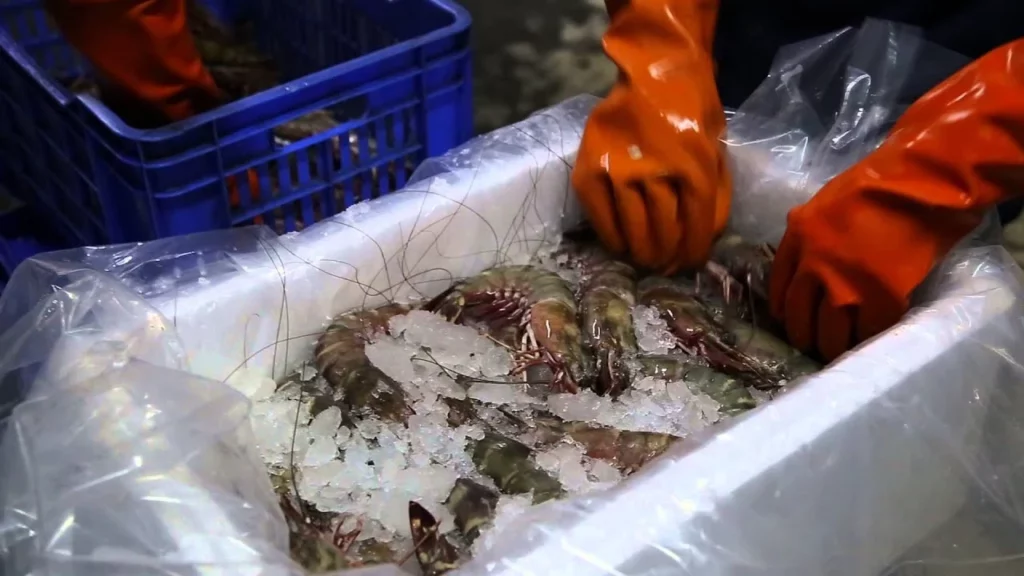
Keeping prawns alive while traveling to export countries is very difficult, but not impossible. You can make the prawns faint while on the way so that they can reach the destination country alive. This method is very popular among exporters because of its high success rate. Instead of dying, the shrimp will just fall asleep on the way. Here's how packing live shrimp by stunning them:
- Choose prawns that are not molting, then place them in a bath filled with water at a lower temperature than pond water (this temperature difference should not exceed 8°C).
- Lower the water temperature slowly to 12-14 °C. The low temperature will completely stun the shrimp, and then their skin will turn black in color. This change will be clearly seen in the color of the legs and the segments. This slow decrease in temperature is very important to do. If not, the shrimp will be forced to change their skin.
- Transport the prawns that have been stunned in a trough and clean the dew that sticks to the shrimp's body.
- Prepare media made of sawdust (without resin content) to store the shrimp when they are stunned. Previously, the powder must have been cooled down to a temperature of 12-14 °C.
- Spread the sawdust on a cardboard base 3 cm thick. After that, arrange the shrimp that have fainted face down. Arrange the rows of shrimp until they fill the surface of the powder.
- Sprinkle the top again with 3 cm thick sawdust. Next, arrange the fainted shrimp again on top of the sawdust.
- Place an ice pack at the top of the container to keep the temperature of the shrimp down.
This way of exporting shrimp can keep the shrimp alive for 24 hours. The risk of shrimp death was only 12%. If it's winter, the risk of death can drop to as little as 3%.
E. Export Distribution
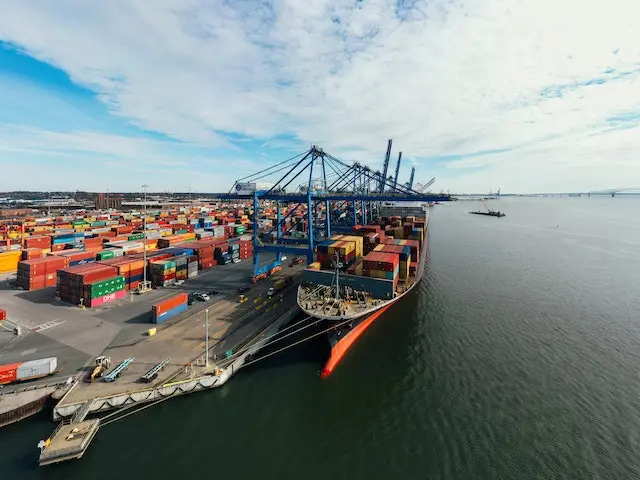
The distribution of shrimp exports is usually by air or by sea, depending on the request of the exporter and the regulations in force. European importers generally use air transportation for fresh and live fishery products, then sea transportation for frozen and packaged products. The following are things that you need to consider when choosing a shrimp export route:
- When viewed from the mode of transportation, shipping shrimp by sea is sent using cargo ships and also Pelni ships. Meanwhile, shrimp shipments by air are sent using cargo planes.
- Timeliness of air delivery is considered better and faster than sea shipping. This can be a consideration for those of you who want a faster delivery time.
- However, when viewed from the accuracy of the delivery location, the sea route is considered superior to the air route because it can reach various areas, including even remote areas. Meanwhile, aircraft can only make deliveries to certain airports.
- The speed of the aircraft in sending shrimp to export destination countries has an effect on higher shipping costs when compared to shipping costs by ship. Thus, you have to prepare more budget to send shrimp by plane.
Export Rejection
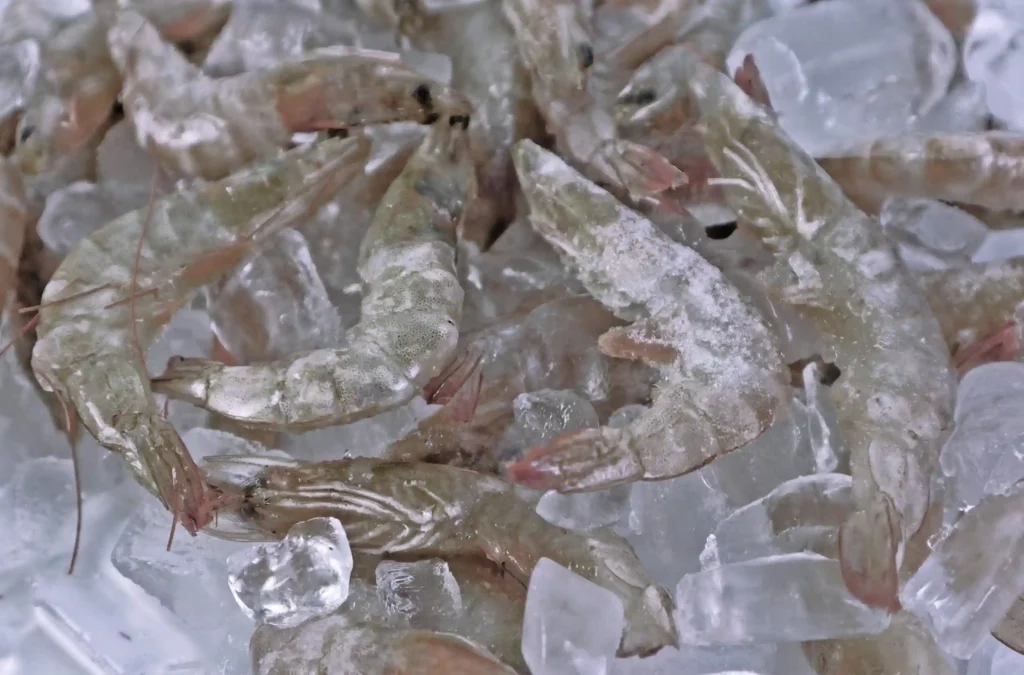
Not always successful, shrimp export shipments from Indonesia have also experienced rejection from importing countries several times. A total of 64% cases of rejection were caused by the presence of pathogenic bacteria and toxins in shrimp such as histamine, 26% were caused by filthy, 6% is caused by chemical residues, and its 4% is caused by misbranding. This shows that the production process in the fishing industry in Indonesia is still not good.
This is in line with the US FDA (The United States Food and Drug Administration) which has determined 4 categories of substances that may not be contained in imported fishery products. According to the US FDA, the presence of pathogenic bacteria, the use of chemicals that exceed the maximum limit, the content of foreign materials that should not be present in the product (filthy), and packaging errors (misbranding) is very dangerous for food products. Apart from that, there is also salmonella bacteria contamination which is the biggest cause of export failure of fishery products from Indonesia. This shows that there are still weaknesses in supervision during the production process of fishery products in Indonesia.
Rejection of shrimp exports as a result filthy, misbranding, or the presence of these pathogenic bacteria is very detrimental to Indonesian exporters. Therefore, before being sent to export destination countries, shrimp must be ensured to be healthy and not dangerous. One of the government's efforts to overcome export refusal is to carry out quarantine. Quarantine is carried out before the shrimp are sent to overseas buyers. Through quarantine, it is hoped that export shrimp commodities containing salmonella or contaminated with unwanted foreign materials can be properly screened.
Need Help Regarding Shrimp Cultivation Business?
Fill in your personal data in the following form. Our team will immediately contact you via the number cellphone attached. Make sure the data entered is correct.
Avoid Export Rejection & Learn Hand in Hand with the Experts in Aquaculture Events
You can get knowledge and successful experience related to shrimp export through webinars Cultivation Event which are regularly held eFishery. Not only talking about shrimp exports, the webinars that are on Cultivation Event will also thoroughly explore various kinds of interesting topics about shrimp farming. Get an invite to follow Acara Budidaya secara gratis by creating an account on efarm app!
Fill out the form above to register on the app eFarm!
Questions Regarding How to Export Shrimp
Following are the procedures for exporting shrimp that you can do:
- Request a permit from the government
- Following the Quarantine Process
- Sending Export Shrimp Shipping Instructions to the Expeditionary Company
- Deliver Booking Confirmation
- Loading Fish Into Expedition Ships or Planes
- Get Bill of Lading
Following are the documents needed to export shrimp:
- Invoice
- HACCP Certificate (Hazard Analysis Critical Control Point), at least Grade B
- NIB (Business Identification Number)
- SIUP (Trading Business Permit) for Processing
- SKP (Tax Assessment Letter)
- Internal Audit Records
- Registration Application Letter Registration Number
- https://customspedia.com/syarat-ekspor-udang-persyaratan-penting-untuk-ekspor-udang/
- https://dkpp.bulelengkab.go.id/informasi/detail/artikel/begini-cara-ekspor-udang-agar-tetap-segar-54
- https://indoforwarding.com/perbedaan-layanan-import-via-udara-dan-laut/
- https://pndice.com/cara-ekspor-udang/
- https://repository.unsri.ac.id/24116/1/Rinto_Prosiding_BBRP2BKP_2011-2-ORI.pdf
- https://shipper.id/blog/operasionalbisnis/cara-menghitung-biaya-ekspor-agar-tidak-rugi
- https://shipper.id/blog/operasionalbisnis/pengertian-hs-code-dalam-ekspor
- https://sip-exim.co.id/news/articles/cara-ekspor-hasil-laut
- https://tambakmilenial.com/blog/cara-ekspor-udang-vaname/
- https://www.pexels.com/photo/cargo-ship-at-unloading-containers-6595777/
